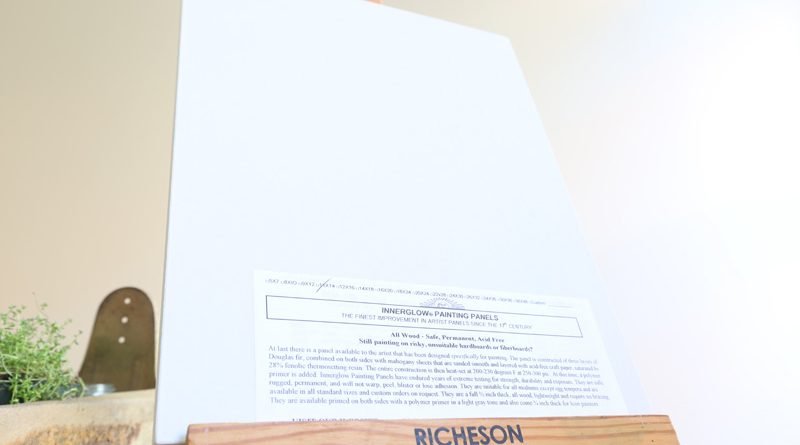Painting Surfaces, Canvas, Boards
Painting Surfaces, Canvas, Boards
In a conversation between Jackie Kamin and Sherrie McGraw, we find out the different painting surfaces that they prefer.
Jackie: Hi Sherrie! Could you tell us what is the best painting surface to work on?
Sherrie: Hi Jackie! For smaller sizes, I prefer smooth boards to paint on. My favorite is the InnerGlow panel. InnerGlow prepares both sides of the board with a polymer primer that is virtually indestructible and gives you two boards in one. They double the number of painting surfaces on which you can paint and make experimentation that much more tempting. You can preserve one attempt while turning it over to experiment on the other side.
Ampersand Gessobord is another alternative.

I prefer having some ‘spring’ off the surface when I’m working with anything larger than 14 x 18“. So I generally use canvas for that. I work on Utrecht Raw Linen #74D that I prime myself.
Jackie: How?
Sherrie: So with painting surfaces, I know you and I just recently have gotten introduced to working on canvas. Canvas I would say is maybe my most favorite surface to work on. In fact, we have a special video on Bright Light Fine Art for Artist Guild Members that describes priming a raw linen canvas from the ground up. The video explains every part of it – all the materials needed, everything.
Now that is my absolutely favorite surface to work on. And so I do periodically prime some raw linen, so that I have it in a roll. I roll it, paint side out, and then I cut it up as I need it. So that’s one way to do it. Another way to do it is to do what you did, which was to find a really fine portrait grade linen which is usually Klassen’s or some sort of Belgian linen. I mean I don’t really buy that, but you did. Right? You bought some?
Jackie: Yes Klassen.
Sherrie: Right. And so basically it’s the portrait grade that I would recommend and Jackie would recommend. Because what it will do when you have a smooth surface, is it really encourages the understanding and the actual doing of brushstrokes. When you have a very rough surface, there are exceptions to this rule. But usually if it’s a very rough surface, people will tend to scrub the paint and they don’t learn how to make a beautiful brushstroke. And that’s something I know that you mostly have painted on boards, which is a type of surface that we also love too, which is a very smooth board called InnerGlow.
And let’s see, is it Bill Ewing? Yes, it’s his company. And so they actually prime both sides of it and the both sides are very smooth. So you can really paint on both sides. Meaning that if you start a painting and get off to a great start and the next day you have a lot of trepidation about getting back into it, you can turn it over. Start the painting again. Start to warm up, maybe try a slightly different idea. And then when you feel comfortable, go back to your original start. I mean, that’s psychologically part of what happens with artists. You get afraid of ruining something that you did and you thought you did well.
Jackie: Yes, it’s a very stable support. It’s actually compressed marine board. They use it for, you know, boats I suppose. Things that are on the water. So it’s a very stable support and the idea of not having to fill grooves that rough cotton or rough linen leave is great. You know how you may have to paint many layers of paint just to fill the grooves that the weave leaves. So it’s a much more difficult endeavor painting on a rough surface.
Sherrie: Well, I mean, or you could be like Nicoli Fechin. He used to just take huge gobs of paint and then just apply it across the surfaces with a brush or palette knife because he liked a really rough surface. So you have to use a tremendous amount of paint to overcome the surface.
Jackie: Correct. It becomes as laborious just getting enough paint on the surface so that then, you can do the painting.
Sherrie: Well, right, right, if you’re doing a kind of normal paint quality. But, there is also one surface that I know that you’ve used also which New Traditions Art Panels has an L600 series.
Jackie: Correct.
Sherrie: And that’s also very smooth. And what we do is we tone our surfaces to a middle value. The tone is the paint that we coat the surface with before we begin painting. It’s a very thin layer of paint, a neutral tone containing burnt umber and ultramarine blue. Something very neutral to get a middle tone. And then it allows the darks to look dark on it and the lights to look light on it. So it makes painting a lot simpler. But the smooth surfaces is, I think, key to being able to paint beautifully and not have to fight your surface.
Jackie: Correct. We like it.
Sherrie: We like it. Yes! And it will really encourage making beautiful brushstrokes and that is what is upper most important to all of us.
Jackie: Yes!
Sherrie: I hope this helped!
Jackie: Yes. Thank you Sherrie!
Join The Artists Guild for Free to Watch the Video.




Leave a Reply
You must be logged in to post a comment.